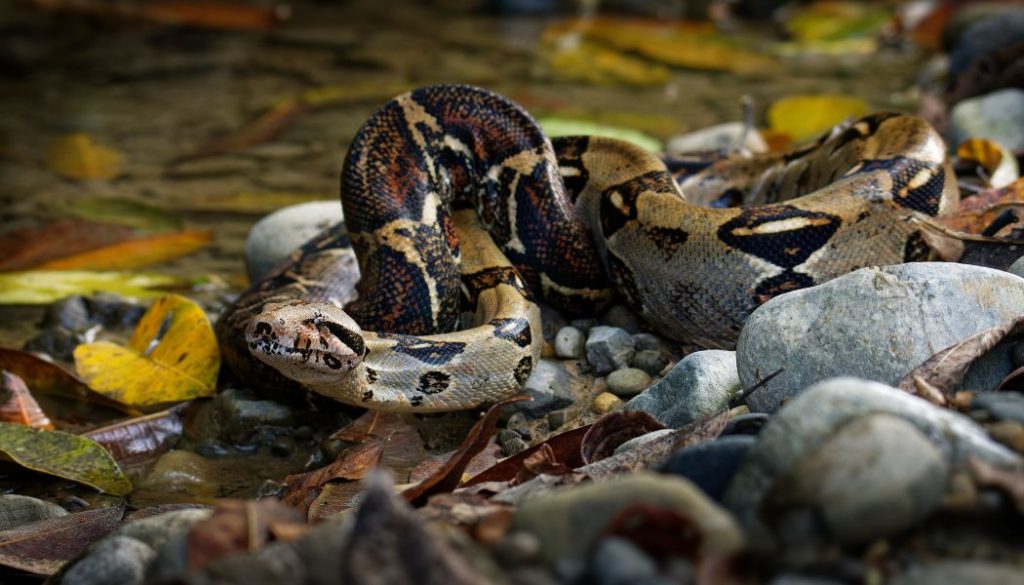Yes, red tail boas can be good for beginners willing to meet their care requirements. They’re generally docile, visually striking, and offer a rewarding experience with proper research and dedication.
In this article, we’re digging deep into the world of red tail boas, especially for those of you considering one as your first slithery companion.
We’ll explore their rising popularity in the pet trade and walk you through essential factors every beginner snake owner should consider.
From maintenance level to costs, common health issues, and even some frequently asked questions, we’ve got you covered. So, are red tail boas good beginner snakes? Stick around to find out!

Table of Contents
- 1 Popularity of Red Tail Boas in Pet Trade
- 2 Factors to Consider for Beginner Snake Owners
- 3 Are Red Tail Boas High Maintenance?
- 4 Cost of Owning a Red Tail Boa
- 5 Common Health Issues Found in Red Tail Boas
- 6 Pros and Cons of Owning a Red Tail Boa as a Beginner
- 7 Conclusion
- 8 FAQ
- 8.1 What is the best beginner boa snake?
- 8.2 Are red tail boas aggressive?
- 8.3 Do red tail boas like to be held?
- 8.4 Are ball pythons good for beginners?
- 8.5 What is the best beginner boa snake?
- 8.6 Are red tail boas aggressive?
- 8.7 Do red tail boas like to be held?
- 8.8 Are ball pythons good for beginners?
Popularity of Red Tail Boas in Pet Trade
Have you ever walked into a pet store or scrolled through a reptile forum and noticed how much people rave about red tail boas?
Yeah, it’s not a coincidence. These guys are like the Kardashians of the snake world—popular, photogenic, and always in the limelight. Just search the hashtag #RedTailBoa on Instagram, and you’ll be flooded with jaw-dropping pictures.
They come in all sorts of colors and morphs that make them an Instagrammer’s dream pet. But hold on a minute! While they’ve got the “wow” factor down, does that mean they’re the right snake for a beginner? Not so fast, my friend.
Popularity can be deceiving, which is why you should look at other factors before committing.
Factors to Consider for Beginner Snake Owners
Alright, aspiring snake parents, pay attention. Owning a snake is a big commitment, and there’s a lot more to it than just posting fabulous snake selfies. Here’s what you need to think about:
Temperament
Before you bring home a red tail boa, you gotta ask: “Is this snake gonna be chill or a handful?” Good news: Red tail boas generally have a pretty relaxed temperament. You won’t find them hissing or making a fuss most of the time.
But here’s the kicker, they do need time to adjust to handling, especially when they’re young. So, if you’re planning on getting a baby red tail, expect to invest some time in getting them used to you.
Feeding Requirements
So, you’re okay with feeding your snake live or frozen-thawed prey, right? Red tail boas aren’t vegan; they need a meaty diet, usually consisting of rats or mice.
And you won’t be feeding them every day; it’s more like once a week for adults and slightly more frequently for young ones. So if the thought of keeping a bag of frozen rodents in your freezer doesn’t sit well with you, you might want to consider another pet.
Habitat Requirements
Let’s talk living arrangements. You can’t just plop a red tail boa into a shoebox and call it a day. These snakes need a sizable enclosure, complete with a heat gradient and high humidity.
You’re going to need a heat lamp, a thermostat, and a hygrometer to make sure your snake feels at home. It sounds like a lot, but once you’ve got the setup done, it’s pretty straightforward.
Are Red Tail Boas High Maintenance?
Okay, so we’ve established that red tail boas have a few specific needs. But does that make them high maintenance? Well, let’s break it down. First of all, these snakes are not the divas some might think they are.
However, they do demand a certain level of care and attention. Your red tail boa will need a stable environment, meaning you’ll have to monitor temperature and humidity levels religiously. Not to mention, a clean enclosure is a must to prevent common health issues like respiratory infections.
They also require a somewhat specialized diet. You can’t just toss in some generic snake chow; you’ll need to feed them the appropriate size and type of rodent. And let’s not forget about regular vet check-ups; you’ll need a vet who’s experienced with reptiles, not just Fluffy and Fido.
So, are they high maintenance? Compared to a rock, absolutely. But if we’re talking snakes, they’re somewhere in the middle. If you’re a beginner willing to put in the effort to learn and provide proper care, a red tail boa is entirely manageable.
Cost of Owning a Red Tail Boa
Alright, let’s talk about the elephant in the room: the cost. The initial expense includes buying the snake, which can range anywhere from $100 to several hundred dollars depending on the morph.
Then there’s the enclosure setup, which includes the tank, heating, and humidity control. You’re looking at another $200 to $300 there, easy.
Ongoing costs include food, which isn’t daily but adds up over time. Think about $2-$5 per rodent, and remember, these guys eat once a week or so. And let’s not forget about potential vet bills, which could be around $50 to $100 for a general check-up, but could go much higher if any health issues arise.
While red tail boas aren’t the most expensive pets to keep, they’re not exactly cheap either. Make sure you’re financially prepared for both the initial and ongoing costs before taking the plunge.
And there you have it! Owning a red tail boa is not for the faint-hearted or the faint of wallet, but if you’re prepared, it can be a rewarding experience.
Common Health Issues Found in Red Tail Boas
In a nutshell, while red tail boas are relatively sturdy, they aren’t completely invincible. As I mentioned, respiratory infections are a common concern, often tied to improper humidity and temperature levels. Keep an eye out for symptoms like wheezing, labored breathing, and mucus discharge.
Next up, we’ve got the pesky issue of mites. These tiny parasites not only make your snake’s life miserable, but they can also spread diseases. Regular cleaning and inspections are key to keeping these critters at bay.
Let’s not forget about digestive issues like constipation or regurgitation. Sometimes this can be a simple case of overfeeding or offering prey that’s too large, but it can also be indicative of more serious health problems.
Lastly, there’s Inclusion Body Disease (IBD), a severe viral illness with no known cure. The symptoms can range from behavioral changes to difficulty with coordination, so it’s important to consult a vet if you notice anything off about your snake’s health.
Regular veterinary check-ups should be a part of your snake’s healthcare regimen. Think of it as an investment in your pet’s long, healthy life.
Pros and Cons of Owning a Red Tail Boa as a Beginner
Alright, you’ve stuck around this long, so let’s get into the nitty-gritty: should a newbie like you get a red tail boa? Let’s weigh the pros and cons.
Pros
- Personality: Red tail boas are generally easy-going and tolerate handling well, especially once they get to know you.
- Low Feeding Frequency: You’re only looking at feeding them once a week or so, making it less of a daily hassle.
- Stunning Appearance: Let’s be real, they’re gorgeous snakes that can make a fantastic centerpiece in your living room, and you’ll never get tired of photographing them.
- Lifespan: With good care, these snakes can live up to 30 years. That’s a long-term companion you can grow with.
- Educational Value: The care requirements, while moderate, offer a great learning curve for budding reptile enthusiasts.
Cons
- Size: These are not small snakes. An adult can grow up to 8-10 feet, requiring a sizable enclosure.
- Cost: Between the enclosure, the food, and vet visits, the costs can add up.
- Feeding: If you’re squeamish about feeding rodents to your pet, this could be a dealbreaker.
- Care Requirements: Proper heat and humidity are essential, requiring you to invest in decent equipment and spend time monitoring the enclosure.
- Health Risks: As we covered, they can be prone to specific health issues that require prompt attention and might necessitate specialized veterinary care.
Conclusion
In conclusion, red tail boas can indeed be suitable for beginners who are ready to invest time and effort into their care.
While their striking appearance and docile nature make them enticing, it’s crucial to weigh the pros and cons carefully.
Remember to maintain proper humidity, temperature, and hygiene to prevent health issues. Start with a well-researched plan and consider alternatives if the size or feeding habits are concerning.
With dedication, red tail boas can become fascinating and rewarding companions, offering a unique journey into the world of snake ownership. So, if you’re up for the challenge, don’t hesitate to embark on this exciting adventure!
FAQ
What is the best beginner boa snake?
If you’re looking for an easygoing boa that’s perfect for beginners, many herpetologists and snake owners recommend the Rosy Boa or the Kenyan Sand Boa. These species are smaller, generally more docile, and have simpler care requirements compared to the red tail.
Are red tail boas aggressive?
Most red tail boas are far from aggressive. They’re typically docile and fairly tolerant of handling. But remember, individual temperament can vary, so it’s best to spend some time with a snake before you bring it home.
Do red tail boas like to be held?
“Like” might be a strong word for a snake, but red tail boas generally tolerate handling quite well. Just give them time to get used to you, especially if they’re young or new to your home. It’s all about building trust.
Are ball pythons good for beginners?
Oh, absolutely! Ball pythons are often recommended for beginner snake owners due to their docile nature and more manageable size. They’re sort of like the golden retrievers of the snake world—friendly, tolerant, and great for families.
What is the best beginner boa snake?
If you’re looking for an easygoing boa that’s perfect for beginners, many herpetologists and snake owners recommend the Rosy Boa or the Kenyan Sand Boa. These species are smaller, generally more docile, and have simpler care requirements compared to the red tail.
Are red tail boas aggressive?
Most red tail boas are far from aggressive. They’re typically docile and fairly tolerant of handling. But remember, individual temperament can vary, so it’s best to spend some time with a snake before you bring it home.
Do red tail boas like to be held?
“Like” might be a strong word for a snake, but red tail boas generally tolerate handling quite well. Just give them time to get used to you, especially if they’re young or new to your home. It’s all about building trust.
Are ball pythons good for beginners?
Oh, absolutely! Ball pythons are often recommended for beginner snake owners due to their docile nature and more manageable size. They’re sort of like the golden retrievers of the snake world—friendly, tolerant, and great for families.




0 Comments